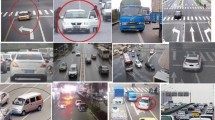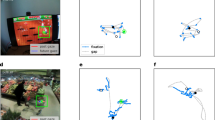Abstract
In this paper, we introduce a computer vision system specially designed for the analysis and interpretation of the cephalo-ocular behavior of drivers. The system is composed of both hardware and software components and is described in three steps. The first step is devoted to the description of the driving simulator and the developed software. The second step deals with the identification of the driver’s visual search actions using computer vision. The latter are related to specific driving events such as blind spot checking and rear-view/lateral mirror verification. Based on the simulator’s open module, the third step is concerned with the identification of car/road events (overtaking, crossing an intersection) and the mapping of these events with the driver’s behavior. The proposed system will be used by a kinesiology research group for the evaluation and improvement of driver performances in a safe environment (driving simulator). In addition to the controlled environment, a modified version of the system also deals with real driving contexts (i.e. driving in a real car). Experimental results confirm both the robustness and the effectiveness of the proposed cephalo-ocular analysis framework.
Similar content being viewed by others
References
Bertalmio M., Sapiro G., Randall G.: Morphing active contours. IEEE Trans. Pattern Anal. Mach. Intell. 22(7), 733–737 (2000)
Bouchard, G., Triggs, B.: A hierarchical part-based model for visual object categorization. In: IEEE Conference on Computer Vision and Pattern Recognition (2005)
Bouguet, J.Y.: Pyramidal Implementation of the Lucas Kanade Feature Tracker Description of the algorithm. Intel Corporation Microprocessor Research Labs (2000)
Comaniciu D., Ramesh V., Andmeer P.: Kernel-based object tracking. IEEE Trans. Pattern Anal. Mach. Intell. 25, 564–575 (2003)
Felzenszwalb P.F., Huttenlocher D.P.: Pictorial structures for object recognition. IJCV 61(1), 55–79 (2005)
Fergus, R., Perona, P., Zisserman, A.: Object class recognition by unsupervised scale-invariant learning. In: CVPR. vol. 2, pp. 264–271 (2003)
Fergus, R., Perona, P., Zisserman, A.: A sparse object category model for efficient learning and exhaustive recognition. In: IEEE Conference on Computer Vision and Pattern Recognition (2005)
Gander W., Golub G., Strebel R.: Least-squares fitting of circles and ellipses. BIT Numerical Mathematics. Springer, Berlin (1994)
Rowley, H.A., Baluja, S., Kanade, T.: Human face detection in visual scenes. In: Advances in Neural Information Processing Systems, vol. 8 (1995)
Kang, J., Cohen, I., Medioni, G.: Object reacquisition using geometric invariant appearance model. In: International Conference on Pattern Recongnition, pp. 759–762 (2004)
Lienhart, R., Maydt, J.: An extended set of haar-like features for rapid object detection. In: IEEE International Conference on Image Processing, pp. 900–903 (2002)
Leibe, B., Leonardis, A., Schiele, B.: Combined object categorization and segmentation with an implicit shape model. In: ECCV workshop on statistical learning in computer vision, pp. 17–32 (2004)
Lucas, B.D., Kanade, T.: An iterative image registration technique with an application to stereo vision. In: International Joint Conference on Artificial Intelligence (1981)
Mikolajczyk, K., Schmid, C., Zisserman, A.: Human detection based on a probabilistic assembly of robust part detectors. In: Proceedings of the 8th European Conference on Computer Vision, May 2004
Mohan A., Papageorgiou C., Poggio T.: Examplebased object detection in images by components. IEEE Trans. Pattern Anal. Mach. Intell. 23(4), 349–361 (2001)
Murphy-Chutorian, E., Doshi, A., Trivedi, M.M.: Head pose estimation for driver assistance Systems: a robust algorithm and experimental evaluation. In: IEEE Intelligent Transportation Systems Conference, pp. 709–714 (2007)
Murphy-Chutorian E., Trivedi M.M.: Head pose estimation and augmented reality tracking: an integrated system and evaluation for monitoring driver awareness. IEEE Trans. Intell. Transp. Syst. 11(2), 300–311 (2010)
Papageorgiou C., Poggio T.: A trainable system for object detection. Int. J. Comput. Vis. 38(1), 15–33 (2000)
Salari V., Sethi I.K.: Feature point correspondence in the presence of occlusion. IEEE Trans. Pattern Anal. Mach. Intell. 12(1), 87–91 (1990)
Sato K., Aggarwal J.: Temporal spatio-velocity transform and its application to tracking and interaction. Comput. Vis. Image Underst. 96(2), 100–128 (2004)
Schneiderman, H., Kanade, T.: A statistical model for 3D object detection applied to faces and cars. In: IEEE Conference on Computer Vision and Pattern Recognition (2000)
Schweitzer, H., Bell, J.W., Wu, F.: Very fast template matching. In: European Conference on Computer Vision, pp. 358–372 (2002)
Shafique, K., Shah, M.: A non-iterative greedy algorithm for multi-frame point correspondence. In: IEEE International Conference on Computer Vision, pp. 110–115 (2003)
Shi, J., Tomasi, C.: Good features to track. In: IEEE Conference on Computer Vision and Pattern Recognition (CVPR), pp. 593–600 (1994)
Sklansky J.: Finding the convex hull of a simple polygon. Pattern Recogn. Lett. 1, 79–83 (1982)
Teasdale, N., Lavallière, M., Tremblay, M., Laurendeau, D., Simoneau, M.: Multiple exposition to a driving simulator reduces simulator symptoms for elderly drivers. In: Proceedings of the Fifth International Driving Symposium on Human Factors in Driver Assessment, Training and Vehicle Design. Big Sky, USA (2009)
Murphy, K.P., Torralba, A., Eaton, D., Freeman, W.T.: Object detection and localization using local and global features. In: Proceedings of Toward Category-Level Object Recognition, pp. 382–400 (2006)
Torralba A., Murphy K.P., Freeman W.T.: Using the forest to see the trees: exploiting context for visual object detection and localization. Commun. ACM 53(3), 107–114 (2010)
Trivedi M.M., Gandhi T., McCall J.C.: Looking-in and looking-out of a vehicle: computer-vision-based enhanced vehicle safety. IEEE Trans. Intell. Transp. Syst. 8(1), 108–120 (2007)
Veeman C., Reinders M., Backer E.: Resolving motion correspondence for densely moving points. IEEE Trans. Pattern Anal. Mach. Intell. 23(1), 54–72 (2001)
Viola, P., Jones, M.: Rapid object detection using a boosted cascade of simple features. In: IEEE Conference on Computer Vision and Pattern Recognition (2001)
Viola, P., Jones, M., Snow, D.: Detecting pedestrians using patterns of motion and appearance. In: IEEE Conference on Computer Vision and Pattern Recognition (2003)
Viola P., Jones M.: Robust real-time object detection. Int. J. Comput. Vis. 57(2), 137–154 (2004)
Wu, J., Trivedi, M.M.: An integrated two-stage framework for robust head pose estimation. In: AMFG, pp. 321–335 (2005)
Author information
Authors and Affiliations
Corresponding author
Rights and permissions
About this article
Cite this article
Metari, S., Prel, F., Moszkowicz, T. et al. A computer vision framework for the analysis and interpretation of the cephalo-ocular behavior of drivers. Machine Vision and Applications 24, 159–173 (2013). https://doi.org/10.1007/s00138-011-0381-5
Received:
Revised:
Accepted:
Published:
Issue Date:
DOI: https://doi.org/10.1007/s00138-011-0381-5




